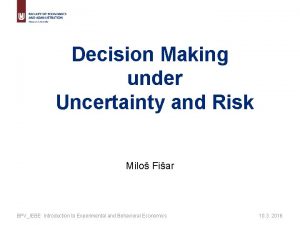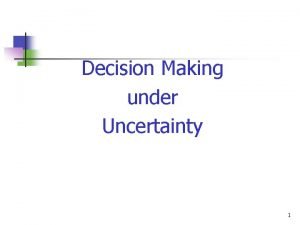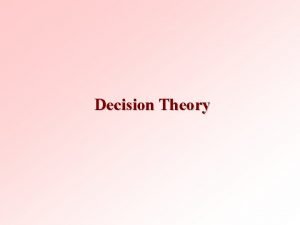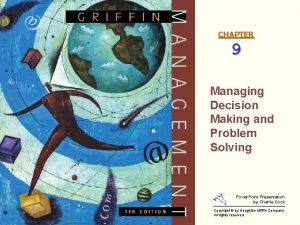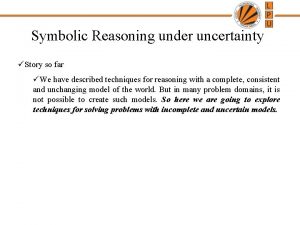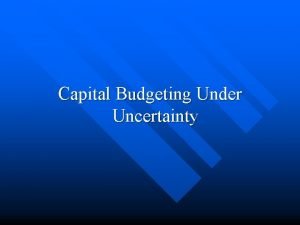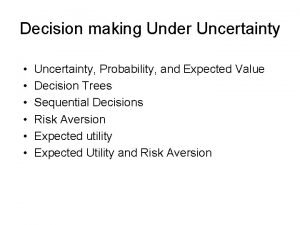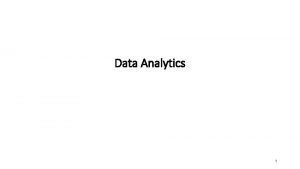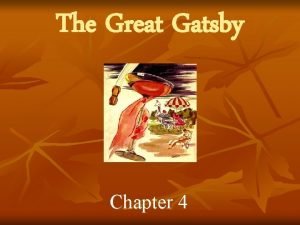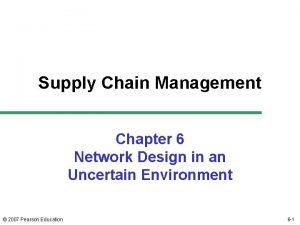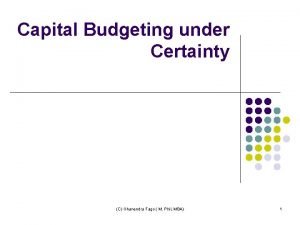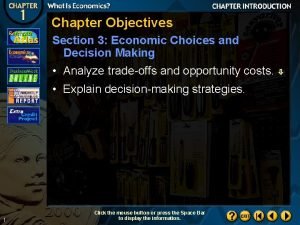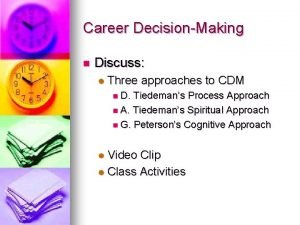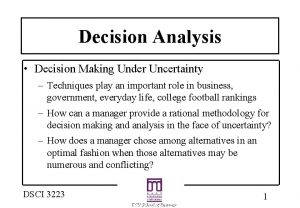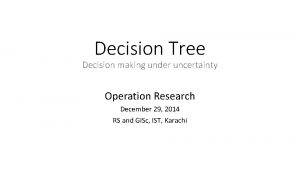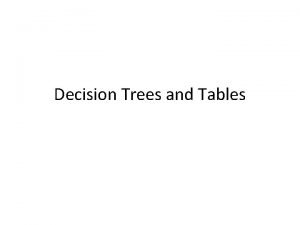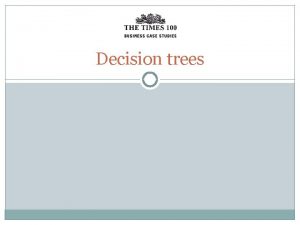Decision Making Under Uncertainty Decision Trees MG 365


















- Slides: 18

Decision Making Under Uncertainty: Decision Trees MG 365

Problem: Jenny Lind is a writer of romance novels. A movie company and a TV network both want exclusive rights to one of her more popular works. If she signs with the network, she will receive a single lump sum, but if she signs with the movie company, the amount she will receive depends on the market response to her movie. What should she do?

Payouts and Probabilities n Movie company Payouts Small box office - $200, 000 ¨ Medium box office - $1, 000 ¨ Large box office - $3, 000 ¨ n TV Network Payout ¨ n Flat rate - $900, 000 Probabilities P(Small Box Office) = 0. 3 ¨ P(Medium Box Office) = 0. 6 ¨ P(Large Box Office) = 0. 1 ¨

Jenny Lind - Payoff Table States of Nature Small Box Office Medium Box Office Large Box Office Sign with Movie Company $200, 000 $1, 000 $3, 000 Sign with TV Network $900, 000 Prior Probabilities 0. 3 0. 6 0. 1 Decisions

Jenny Lind - How to Decide? n What would be her decision based on: ¨Maximax? ¨Maximin? ¨Expected Return?

Using Expected Return Criteria EVmovie=0. 3(200, 000)+0. 6(1, 000)+0. 1(3, 000) = $960, 000 = EVUII or EVBest EVtv =0. 3(900, 000)+0. 6(900, 000)+0. 1(900, 000) = $900, 000 Therefore, using this criteria, Jenny should select the movie contract.

Something to Remember Jenny’s decision is only going to be made one time, and she will earn either $200, 000, $1, 000 or $3, 000 if she signs the movie contract, not the calculated EV of $960, 000!! Nevertheless, this amount is useful for decisionmaking, as it will maximize Jenny’s expected returns in the long run if she continues to use this approach.

Expected Value of Perfect Information (EVPI) What is the most that Jenny should be willing to pay to learn what the size of the box office will be before she decides with whom to sign?

EVPI Calculation EVw. PI (or EVc) =0. 3(900, 000)+0. 6(1, 000)+0. 1(3, 000) = $1, 170, 000 EVBest (calculated to be EVMovie from the previous page) =0. 3(200, 000)+0. 6(1, 000)+0. 1(3, 000) = $960, 000 EVPI = $1, 170, 000 - $960, 000 = $210, 000 Therefore, Jenny would be willing to spend up to $210, 000 to learn additional information before making a decision.

Using Decision Trees n Can be used as visual aids to structure and solve sequential decision problems n Especially beneficial when the complexity of the problem grows

Decision Trees n Three types of “nodes” Decision nodes - represented by squares (□) ¨ Chance nodes - represented by circles (Ο) ¨ Terminal nodes - represented by triangles (optional) ¨ n n n Solving the tree involves pruning all but the best decisions at decision nodes, and finding expected values of all possible states of nature at chance nodes Create the tree from left to right Solve the tree from right to left

Example Decision Tree Chance node Decision 1 n o node Decisi Dec i sio n 2 Event 1 Event 2 Event 3

Jenny Lind Decision Tree Small Box Office Sign with Movie Co. Medium Box Office Large Box Office Small Box Office Sign with TV Network Medium Box Office Large Box Office $200, 000 $1, 000 $3, 000 $900, 000

Jenny Lind Decision Tree ER ? Sign with Movie Co. Small Box Office. 3. 6 ER ? . 1 ER ? Sign with TV Network Medium Box Office Large Box Office Small Box Office . 3. 6. 1 Medium Box Office Large Box Office $200, 000 $1, 000 $3, 000 $900, 000

Jenny Lind Decision Tree - Solved ER 960, 000 Sign with Movie Co. ER 960, 000 Small Box Office. 3. 6. 1 Medium Box Office Large Box Office Small Box Office ER 900, 000 Sign with TV Network . 3. 6. 1 Medium Box Office Large Box Office $200, 000 $1, 000 $3, 000 $900, 000

Class Exercise: A Glass Factory A glass factory specializing in crystal is experiencing a substantial backlog, and the firm's management is considering three courses of action: A) Arrange for subcontracting B) Construct new facilities C) Do nothing (no change) The correct choice depends largely upon demand, which may be low, medium, or high. By consensus, management estimates the respective demand probabilities as 0. 1, 0. 5, and 0. 4. Given the payoffs on the next page, manually create and solve this problem using a decision tree.

A Glass Factory: The Payoff Table The management estimates the profits when choosing from the three alternatives (A, B, and C) under the differing probable levels of demand. These profits, in thousands of dollars are presented in the table below:

Class Exercise: Insurance Policy A store owner is currently considering insuring the contents of his store against theft for one year. He estimates that the contents of his store would cost him $20, 000 to replace. Local crime stats indicate that there is a probability of 3% that his store will be broken into this upcoming year. In the event of a theft his losses would be 10%, 20% or 40% of the contents with probabilities 0. 5, 0. 35, 0. 15 respectively. An insurance policy from Company A costs $150 a year but guarantees to replace all losses due to theft. A policy from Company B is cheaper at $100 but with a $50 deductible. Company C costs only $75 a year but only covers 40% of the losses. Assume only one theft per year. Draw a decision tree and make a decision on buying a policy.
 Decision-making under uncertainty
Decision-making under uncertainty Decision-making under uncertainty
Decision-making under uncertainty Criterion of realism (hurwicz)
Criterion of realism (hurwicz) Example of non programmed decision
Example of non programmed decision Reiters
Reiters Capital budgeting under risk and uncertainty
Capital budgeting under risk and uncertainty Expected profit under uncertainty
Expected profit under uncertainty Financial decision
Financial decision Objectives of decision making
Objectives of decision making Ratio data example
Ratio data example Forty second street cellar
Forty second street cellar Decision tree supply chain
Decision tree supply chain Data and process modeling
Data and process modeling Is making inference simply making a guess
Is making inference simply making a guess War making and state making as organized crime
War making and state making as organized crime Investment decision under certainty
Investment decision under certainty Chapter 1 section 3 economic choices and decision making
Chapter 1 section 3 economic choices and decision making Three approaches of decision making
Three approaches of decision making Management chapter 5 planning and decision making
Management chapter 5 planning and decision making
